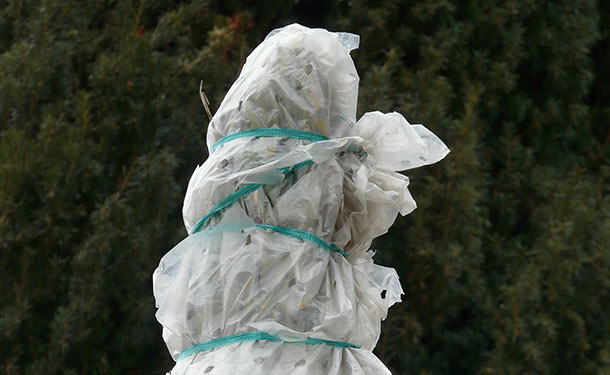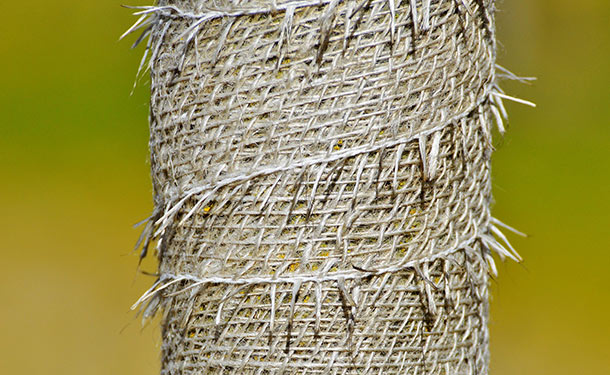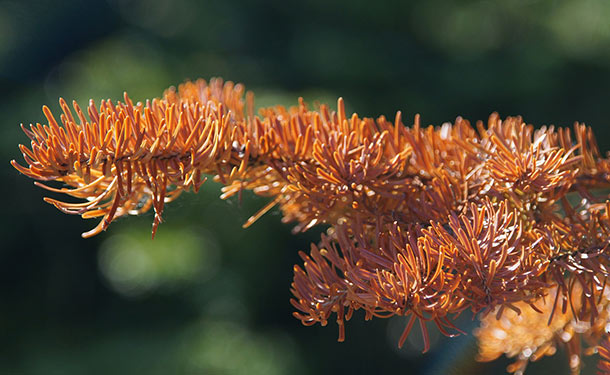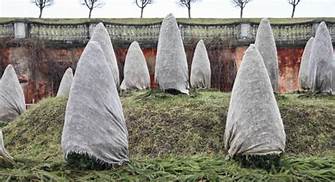Written by Jasper Boekelman and published on https://www.thetreecareguide.com/
Wrapping the trunk of your trees when they go dormant protects the bark from damage or possible splitting. Most tree growers know that maintaining the tree’s health in winter is crucial to ensure they’re all set for a successful growing season.
A tree wrap is a huge part of essential tree care in winter. Young trees are susceptible to girdling animals that dig holes up in a snug spot among your trees.
Besides, extreme cold can be stressful on trees, especially on saplings not yet able to establish a rooting system like mature trees.
Wrapping Trees for Winter
Prevent tree damage and death during harsh winter months. Knowing how to prepare and protect your trees through the coldest months of the year will help them grow and thrive when spring arrives.

thetreecareguide.com gathered information on wrapping trees for the winter and why it is essential to prepare and protect trees from hazards that come with cold weather.
Tree Wrap
When your trees are young, have thin bark, or are arborvitae, they require a bit of extra attention to make it through severe cold weather. When trying to decide how or if to wrap your tree, consider the following:
Deciduous Trees – During autumn months, deciduous trees not only lose their leaves, but their metabolism also slows down in preparation for dormancy. After planting, the trunk should be wrapped or protected from the root flare (at the bottom of the trunk) up to the first set of lower branches during the first five years.

- Tree wraps should be made from a breathable material (burlap, Kraft paper, etc.) that does not adhere to the tree. These wraps protect the bark from suffering sunscald.
- Tree protectors are generally made from a more sturdy material (vinyl, PVC, plastic) that loosely fit around the trunk and protect the tree from sunscald and wildlife. Specifically, deer that use tree trunks to rub their antlers.
Sunscald, also called southwest injury, occurs during late winter and early spring when:
- Tree bark is exposed to cold or freezing temperatures
- The sun comes out and heats up the bark (this activates tree cells, breaking dormancy)
- The sun is then blocked or goes down, and the warmed bark rapidly drops in temperature
Exposure to such temperature fluctuations ends up damaging tree cells and can severely interrupt the phloem and xylem located beneath the bark. Sunscald will likely lead to:
- Sunken, discolored areas of bark
- The formation of cankers in affected areas
- Bark cracking or splitting
Deciduous trees most susceptible to sunscald include young or newly planted trees, those trees suffering from drought conditions, and hardwoods with thin bark. At-risk species include:
- Poplar
- Aspen
- Maple
- Sycamore
Tip: For best results, avoid using material that adheres to tree bark or tightens/shrinks around the tree’s trunk.
Watch this video to see how to apply tree wrapping.
Evergreen Trees – Evergreens, like deciduous trees, can suffer crippling damage during winter months. If your evergreens have suffered from the following, they should be wrapped for the winter:
- Newly planted or transplanted
- Exposed to high or constant wind
- Exposed to drought or exhibits signs of drought (yellowing, browning, or becoming brittle)
- Has been affected by infestation or disease

Wrapping your evergreen trees and shrubs can be accomplished in several ways. Here are two effective methods:
Method One – For this method, you will physically wrap the tree with burlap:
- Loosely wrap the tree from its base to its tip
- Use twine (around the tree) to tie the bottom, middle, and top of the tree
Be careful not to tightly “mummify” the tree. The wrap should be able to breathe, and the twine should be snug but not tight enough to damage the foliage or branches.
Method Two – In this method of tree trimming, you are erecting a barrier around the tree and will need three stakes slightly taller than the tree:
- Mark a triangle in the soil around the tree (large enough for the entire tree to fit inside)
- One point of the triangle should be on the side of the tree that gets the most wind
- Drive one stake in front of the tree (the side that gets the most wind)
- Drive the other two stakes at the other points of the triangle
- Stretch burlap around the tree, stapling it to the stakes as you go
The end result of this method should appear to be a triangular fence around your evergreen.
When To Remove Tree Wrap
Tree removal is something else and guards and wraps should be removed in early spring. Watch your deciduous trees and shrubs, when they break dormancy and begin their growing season, guards and wraps should come off.
While these protective materials can preserve your tree in the colder months, it can provide a perfect, moist environment for insect infestations and trunk disease growth.
As the growing season begins, be sure to remove guards and wraps before applying pest control products, and keep them off until needed for the next winter.
Tip: If you plant landscape trees in spring, leave the trunks unwrapped until late fall to allow the bark to harden/thicken.
Winter Tree Protection
Using tree wraps and guards is an effective way to preserve your trees’ health in their youth. However, the greatest way you can aide your trees is by promoting their health and vigorous growth. You can do this by:
- Ensuring your trees are well-watered throughout the year
- Mulching the root plate to conserve moisture and regulate ground temperature
- Seasonally and properly prune
- Fertilize when necessary
- Prevent or immediately treat infestations and signs of disease
Note: The combination of proper watering and mulching helps prevent winter heaving (repeated ground freezing and thawing, that pushes roots to the surface).

Tip: Have all of your trees and landscape annually inspected by an arborist. Their trained eyes can help you avoid or correct issues that most people fail to detect until massive damage has already occurred.
Protecting Trees in Winter
In this article, you discovered information about wrapping trees and using tree guards to protect them from the dangers accompanying winter months.
Taking measures to protect your trees during winter helps them remain healthy and vigorously grow in the spring.
Leaving your trees exposed to the elements can cause severe damage, weakening your trees’ health, leaving them susceptible to disease and deadly infestation.
Original post here https://www.thetreecareguide.com/wrapping-trees-for-winter/.


